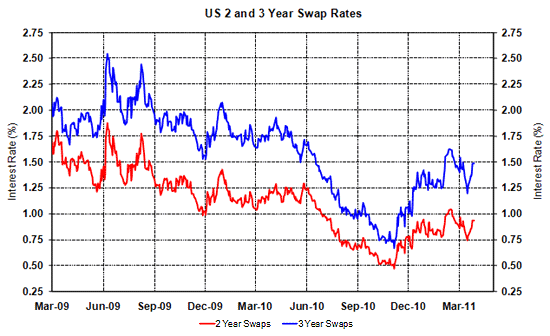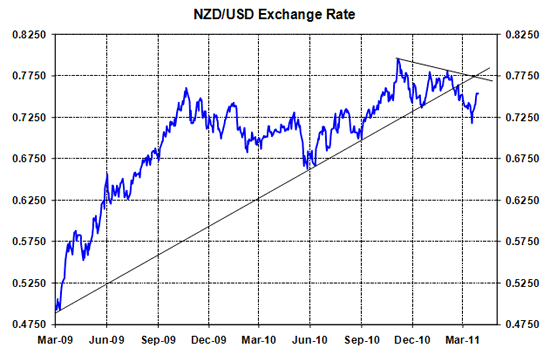

By Roger J Kerr
The NZ dollar has traded in a volatile and wildly fluctuating range between 0.7120 and 0.7570 over the last 10 days.
In a period when very low interest rates in New Zealand were supposed to reduce NZD exchange rate volatility, the Kiwi has been buffeted around by both global and local events/developments.
The day-to-day currency market volatility displays no signs of abating as global investors switch erratically between positions of "risk on" and "risk off" in response to economic and political news.
The NZD is bought and sold in accordance with that changeable daily investor sentiment.
The rebound in the Kiwi over recent days has been as spectacular as the sell-off when Japanese currency speculators were "stopped-out" of long NZD/short JPY positions just after the Japanese earthquake when the Yen strengthened. Since then a number of forces have culminated together to reverse the NZD direction and return it to where it came from above 0.7500:-
- The Australian dollar is suddenly back in favour as commodity prices reversed back up again after the initial sell-off immediately after the Japanese earthquake. The AUD has broken above the previous resistance against the USD at $1.0150 and trades a cent higher currently in the markets.
- The NZ Government Debt Management Office took the opportunity of strong investor demand last week by upping the weekly tender amount of new issue bonds. It was clear that many of the Asian and US investors, seeking the safety and diversification of NZ Government Bonds in an uncertain world, were not simultaneously hedging forward their FX risk. These investors just bought the NZD’s outright to buy the bonds, pushing the currency back up again.
- GDP growth figures for the December 2010 quarter released last Thursday were a 0.2% increase over the previous quarter. A result that avoided the double-dip recession tag, however the forex markets must have been positioned to expect a negative number, as the NZD immediately appreciated as short-sold positions in the market were forced to be reversed. Despite the disruptions of the Christchurch earthquake, it is not all doom and gloom in the NZ economy.
- The USD itself has remained under pressure as the global FX markets price for European interest rate increases next month. However, the Euro has been unable to attract “follow-through” buying above $1.4000 as some ECB Board-members tone down their rhetoric about the need for interest rate increases to contain inflation.
Will the NZD/USD rate continue higher to 0.7700/0.7800 over coming weeks or drift off again towards 0.7200?
There is sufficient volatility and uncertainty about to cause a move either way; however a return to 0.7200 appears a higher probability based on offshore currency movements.
The weakness in the USD against the Euro to $1.4000 has been a little surprising given the continuing improvement in US economic data across the board. US employment and PMI (Purchasing Managers Index) data later this week should reinforce the view that the US economy is now expanding under its own steam.
The US Federal Reserve is starting to recognise this improvement and short-term swap interest rates are already pricing-in US interest rate increases for later this year (see chart below).
If the Europeans start to get cold feet on their interest rate increases due to ongoing uncertainties on how the financial stability/debt bail-out packages for the southern states will operate, the USD should make gains back to $1.3500 against the Euro.

Where crude oil prices go from current elevated levels is also a major determinant of general commodity price direction (and thus AUD and NZD direction).
Middle-East political developments have been behind the recent oil price increases due to supply worries. While an early resolution to the Libyan situation is unlikely, the latest move up in oil prices may have run its course.
A stronger USD from here and no further increases in commodity prices should limit additional AUD gains against the USD. Current NZD/USD exchange rates above 0.7500 appear to be another forward hedging opportunity for USD importers.
The NZ dollar has broken decisively below its uptrend support line that it has stayed above since the 0.5000 lows of March 2009.
It would now need to trade above 0.7700 0.7000 to break out of the new downtrend pattern.

--------------------
* Roger J Kerr runs Asia Pacific Risk Management. He specialises in fixed interest securities and is a commentator on economics and markets. More commentary and useful information on fixed interest investing can be found at rogeradvice.com

We welcome your comments below. If you are not already registered, please register to comment.
Remember we welcome robust, respectful and insightful debate. We don't welcome abusive or defamatory comments and will de-register those repeatedly making such comments. Our current comment policy is here.